1976 CHEVROLET MONTE CARLO tire pressure
[x] Cancel search: tire pressurePage 5 of 102

Downloaded from www.Manualslib.com manuals search engine Front Seat Back ... ~'""\ ..
Front seat backs on two-door
styles are equipped with a self-lock
ing mechanism to
.• keep the seat
back locked in
phlge while in the
up position. The lock release lever
is located on the upper outboard
portion of the
s~at back.
To tilt the
sell,t back forward,
rotate the levertearward and tilt
the seat back
f?rward. When the
seat back
is r¢turned to the up
position,
• the se~t back will auto
matically 'lock.
Keep
belt re~traints.and buckles
clear of mechanism when tilting
folding seats
forward or backwards,
to help prevent damage
to these
belt systems.
Power Operated Front Seats
The six-way power seat control switch
is located
on the driver's seat
left side panel.
The seat can be operated
as
follows:
I. The front control provides up
and down movement of the
frontof the seat.
2. The center control provides
forward and backward move
ment and up and down move
ment of the entire front seat.
3. The provides up
and of the
Power Windows ,
Power windows have an ignition
interlock
so the windows cannot be
operated unless the ignition switch
is in the "on" position.
1-3
REMINDER: Remove the ignition
key when the vehicle
is not at
tended by a responsible person. A
master control for all windows
is
provided at the driver's position,
Individual switches are provided
under each window for passenger
use.
Inside Rearview Mirrors
Switch mirror to night position
to reduce glare from following
headlights. To raise or lower
mir
ror to achieve desired field of.view,
grasp mirror and exert sufficient
pressure by pushing or pulling up,
down or sideways.
Page 12 of 102
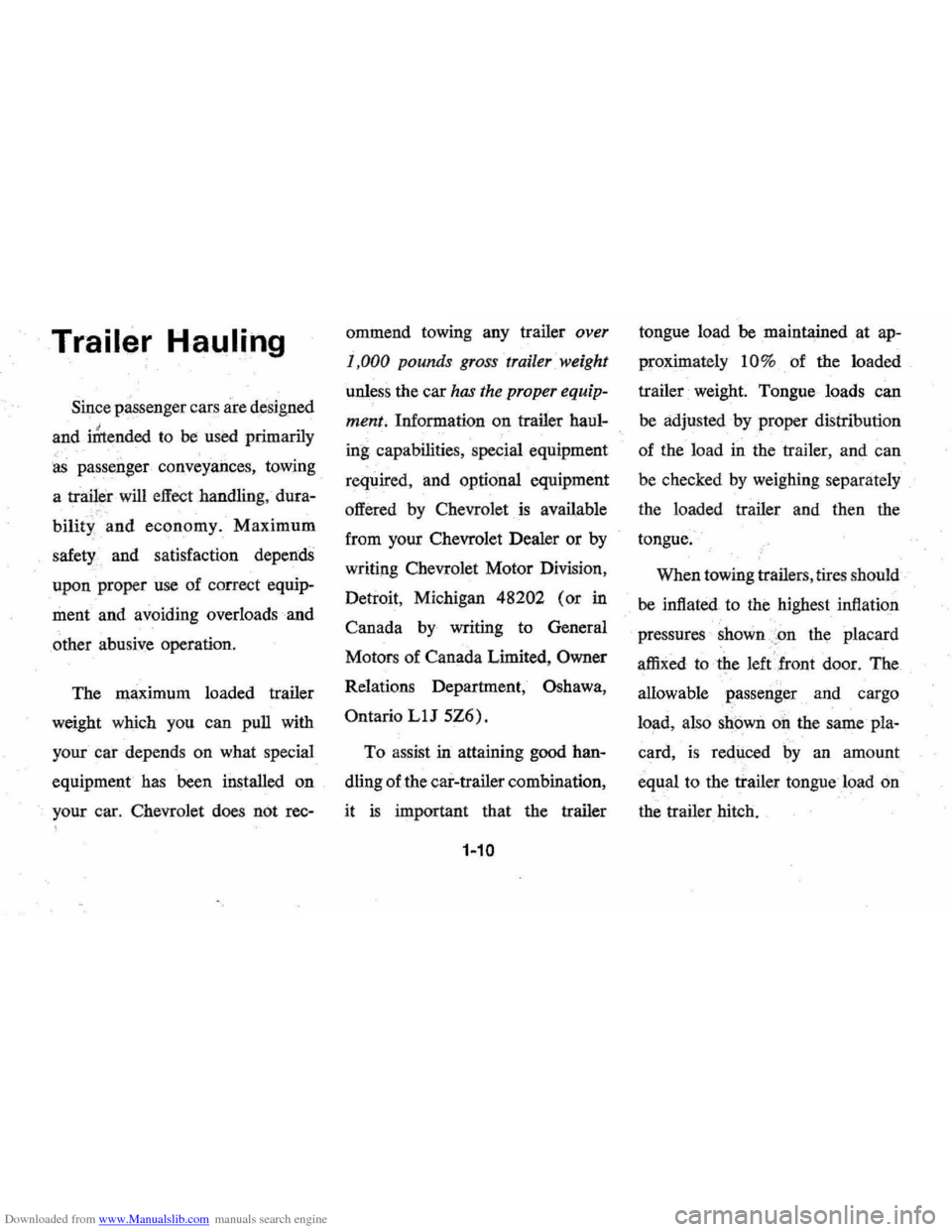
Downloaded from www.Manualslib.com manuals search engine Trailer Halllihg
Since passenger cars are designed
and
i~ended to be used primarily
as passenger conveyances, towing
a
trailer will effect handling , dura-
" bility and economy. Maximum
safety and satisfaction depends
upon proper use of correct equip
ment and avoiding overloads and
other abusive operation.
The maximum loaded trailer
weight which you can pull with
your car depends on what special
equipment has been installed
on
your car. Chevrolet does not rec-ommend
towing any trailer
over
1,000 pounds gross trailer weight
unless the car has the proper (!quip
ment .
Information on trailer haul
ing capabilities, special equipment
required , and optional equipment
offered by Chevrolet
is available
from your Chevrolet Dealer or by
writing Chevrolet Motor Division,
Detroit, Michigan
48202 (or in
Canada by writing to General
Motors of Canada Limited,
Owner
Relations Department, Oshawa,
Ontario LlJ 5Z6).
To assist in attaining good han
dling of the car-trailer combination,
it is important that the trailer
1-10
tongue load be maintained at ap
proximately
10% of the loaded
trailer weight. Tongue loads can
be adjusted by proper distribution
of the load in the trailer, and can
be checked
by weighing separately
the loaded trailer and then the
tongue.
When towing trailers, tires should
be inflated to the highest inflation
pressures
shown :on the placard
affixed to
the left' front door. The
allowable passenger and cargo
load , also shown
on the same pla
card,
is reduced by an amount
eq ual to the trailer tongue load on
the trailer hitch.
Page 48 of 102

Downloaded from www.Manualslib.com manuals search engine l,nCase of Emergency '
Four Way Hazard
Warning Flasher
• Use the warningJlashe~ to warn
othe~ drivers allY time your ve
hicle becomes a traffic hazard,
day
ornight. ",
•
A void stopping on the roadway
if possible, .
.' Turn on the hazard warning
flasher
by pt\'shing in on the but,
ton located on the column just
below the steering
wheeL Flasher
can
be actuated with engine igni
tion either off
or on.
• Turn signals do not work with
hazard flashers operating.
• If the brake pedal is depfessed,
the lights will not flashbutre
main continuously lit
• To cancel the flasher, pull the
button out.
'':.',
Freeing Car From Sand; etc.
If it becomes 'neces sary to rock
the car to free it from sand, mud
or snow, move the selector lever
on automatic transmission models
from '~D" to "R" in a repeat pat
tern while simultaneously applying
moderate pressure to the accelera-
3-1
tor. Do not race engine. For best
possible traction, avoid spinning
wheels while
trying to free the car.
The use of AC Liquid Tire Chain
is recommended for temporary as
sistance when traction is lost on ice
or snow.
Towing
Proper lifting and towing equip
ment
is necessary to prevent dam
age to the vehicle during any
tow
ingoperation. State (Provincial in
Canada) and local
laws applicable
to vehicles in tow must be followed.
Detailed towing instructions are
available at your Chevrolet dealer.
Page 56 of 102
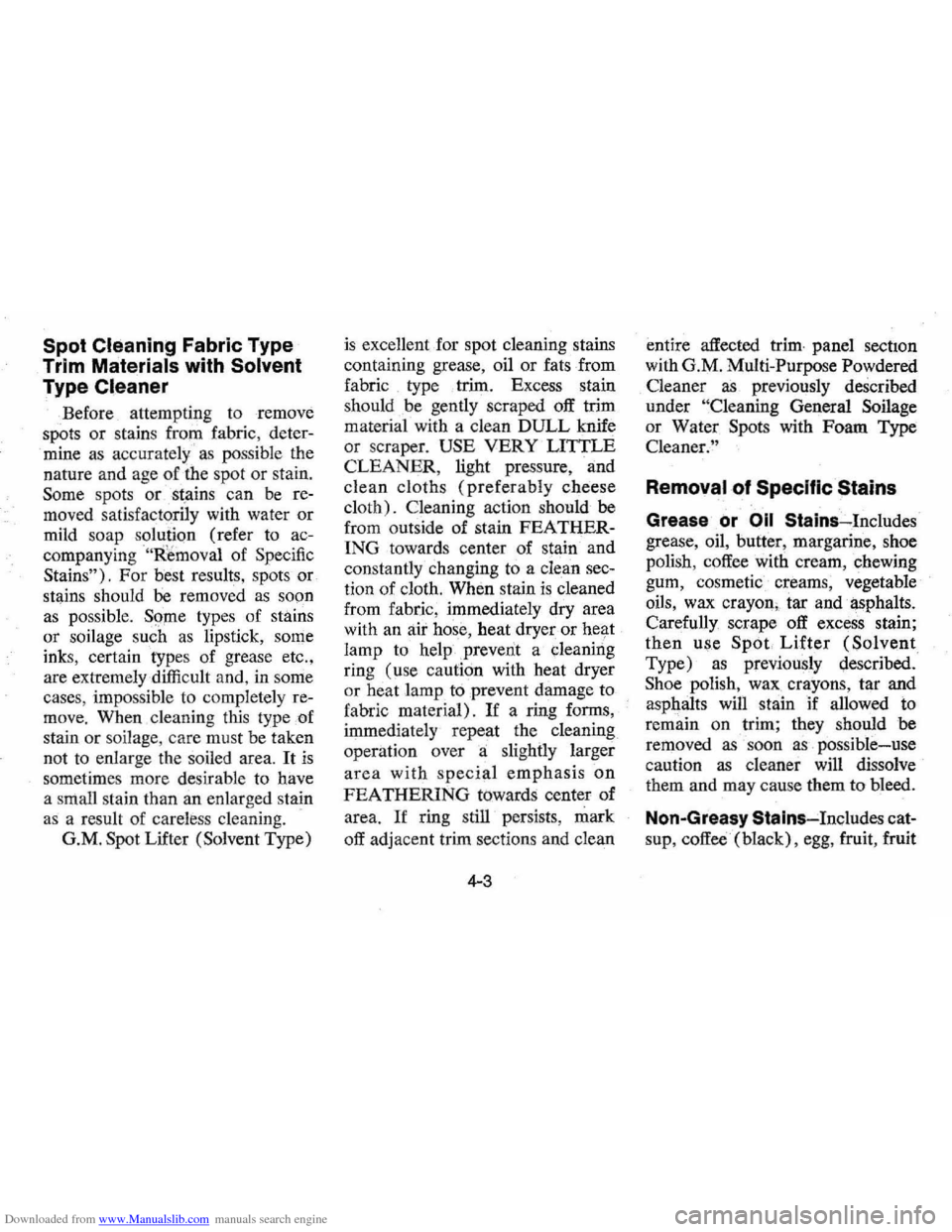
Downloaded from www.Manualslib.com manuals search engine Spot Cleaning Fabric Type
Trim
Materials with Solvent
Type Cleaner
Before attempting to remove
spots or stain s from fabric, deter
mine as accurately
as possible the
nature and age of the spo t
or stain.
Some spo ts or st.ains can be re
moved sa
tisfactorily with water or
mild soap
solution (refer to ac
companying
'' It'emoval of Specific
Stains"). For best results, spots or
stains should
be removed as soon
as possible . S9rne types of stains
or soilage such
as lipstick, some
inks , certain typ
es of grease etc.,
are extrem ely difficult and, in some
cases , impossible to completely re
move. When cleaning this type .of
stain or soilage, care must be taken
not to enlarge the soiled area.
It is
sometimes more desirable to have
a small stain than an enlarged stain
a s a result of careless cleaning.
~
G.M. Spot Lifter (Solvent Type)
is excellent .for spot cleaning stains
containing grease, oil or fats from
fabric type trim. Exces s stain
should be gently scraped off trim
material with a clean
DULL knife
or
scraper. USE VERY LITTLE
CLEANER, light pressure , and
clean cloths (preferably cheese
cloth). Cleaning action should
be
from outside of stain FEATHER
ING toward s center of stain and
constantly changing to a clean sec
tion of cloth. When stain
is cleaned
from fabric, immediately dry area
with an
air hose, heat dryer or heat
lamp to
helppreverit a cleaning
ring (use caution with heat dryer
or heat lamp
to prevent damage to
fabric materi
al). If a ring forms,
immediately repeat the cleaning
operation over
a slightly larger
area with special emphasis on
FEA THERlNG towards center of
area.
If ring still persists, mark
off adjacent trim sections and clean
4-3
entire affected trim panel sectIOn
with G.M. Multi-Purpose Powdered
Cleaner
as previously described
under "Cleaning General Soilage
or Water
Spots with Foam Type
Cleaner."
Removal of Specific Stains
Grease or 011 Stains-Includes
grease, oil, butter , margarine shoe
polish , coffee with cream,
ch~wing
gum, cosmetic creams, vegetable
oils, wax crayon; tar and asphalts.
Carefully scrape
off excess stain;
then us.e Spot. Lifter (Solvent
Type) as previously described.
Shoe polish, wax crayons, tar and
asphalts will stain
if allowed to
remain on trim; they should
be
removed as soon as· possible-use
caution
as cleaner will dissolve
them and may cause them to bleed.
Non-Greasy StaIns-Includes cat
sup, coffee (black), egg, fruit, fruit
Page 75 of 102
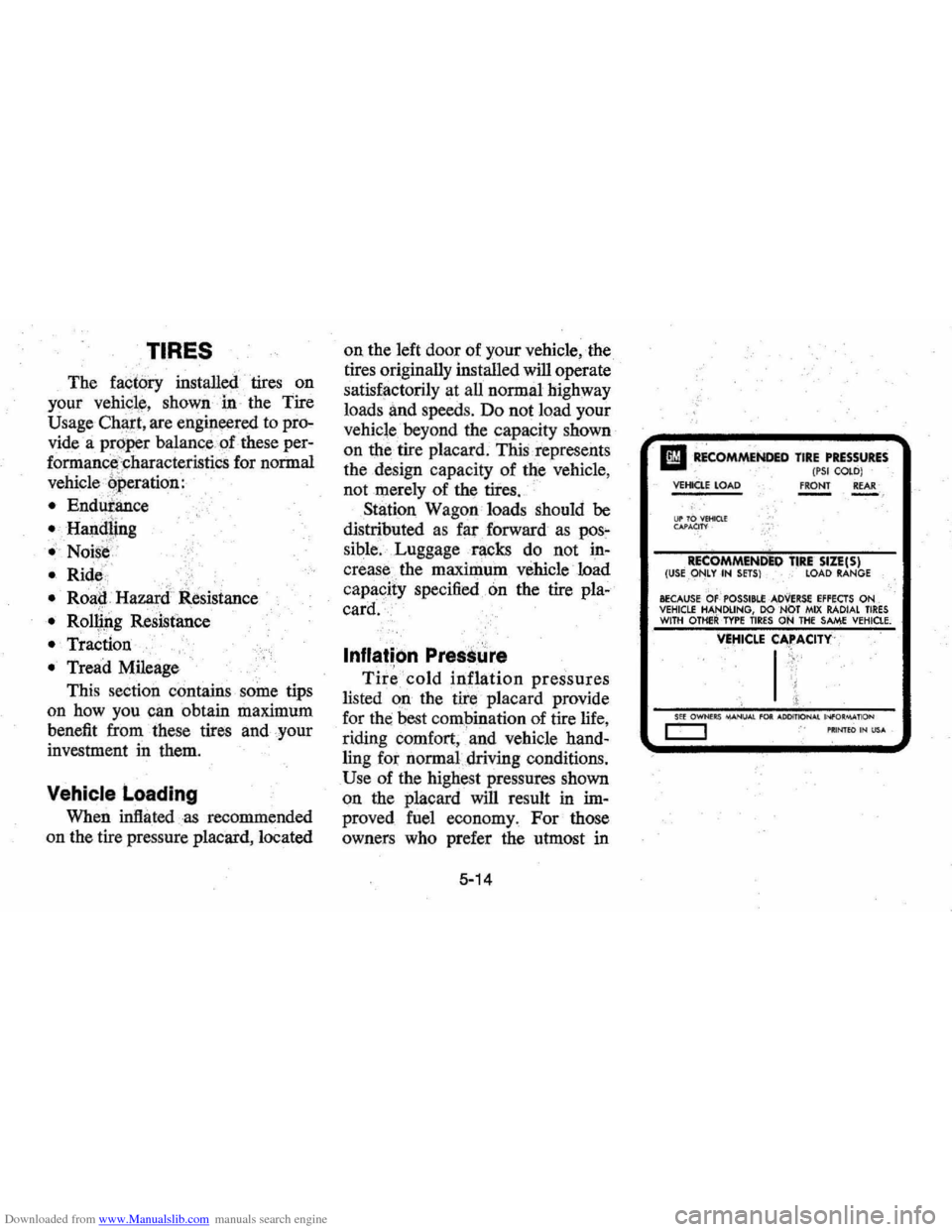
Downloaded from www.Manualslib.com manuals search engine TIRES
The factory installed tires on
your
vehicl ,e , shown in · the Tire
Usage Ch
per
formance'characteristics
for normal
vehicle
~peration:
• Endu tiLnce '.~"
• Handling . ,'c'
• Noise·'
• Ride; .. /.
• Roaa Hazard ~esistance
• Rol~!1g Re~l$tiLnce
• Traction .'. .. ,
• Tread
Mileage .
This section contains some tips
on
how you can obtain maximum
benefit from these tires and your
investment in them.
Vehicle Loading
When inftiltedas recommended
on the tire pressure placard, located on
the left door
of your vehicle , the
tires originally installed will operate
satisfactorily at all normal highway
loads
and s peeds. Do not load your
vehicle beyond the capacity shown
on the tire placard . This represents
the design capacity of the vehicle ,
not merely of the tires .
Station Wagon loads
Should be
distributed as far forward as pos~
sihle . .Luggage racks do not in
crease
the maximum vehicle load
capaciiy specified. on the tire
pla
card.
Inflation Presslire
Tir~' cold inflation pressures
listed ' on the tire placard provide
for
the best combination of tire life,
riding ' comfort , . and vehicle
hand
ling for normal . driving conditions .
Use of the highest pressures shown
on the placard will result
in im
proved fuel economy. For those
owners
who prefer the utmost in
5-14
I
II REcOMMENDED TIRE PRESSURES - (PSI COlO) : YeHKlE LOAD fRONT REAR - ,
ur TO V1:HICI.! ~"m ;,..'
RECOMMENbiO TIRE SIZE(S) (USEQNLY IN SETS) LOAD RANGE .
BECAUSE, :O':'POSSI8LE ·A ,DYERSE EFFECTS ON VEHICLE HANDLING, DO 'NC)T MIX RADIAL TIRES WITH OTHER' TYPE TIRES oN THE SAME VEHICLE.
IIE!iICLE C"'~ACITY ~~,' ; ,',
j
, ~ SU OWNUS ~\) ..... fOft "'DOIflONAl l.'IfOR"'-"TION
c:::J I'I!INTEO IN USA _
Page 76 of 102
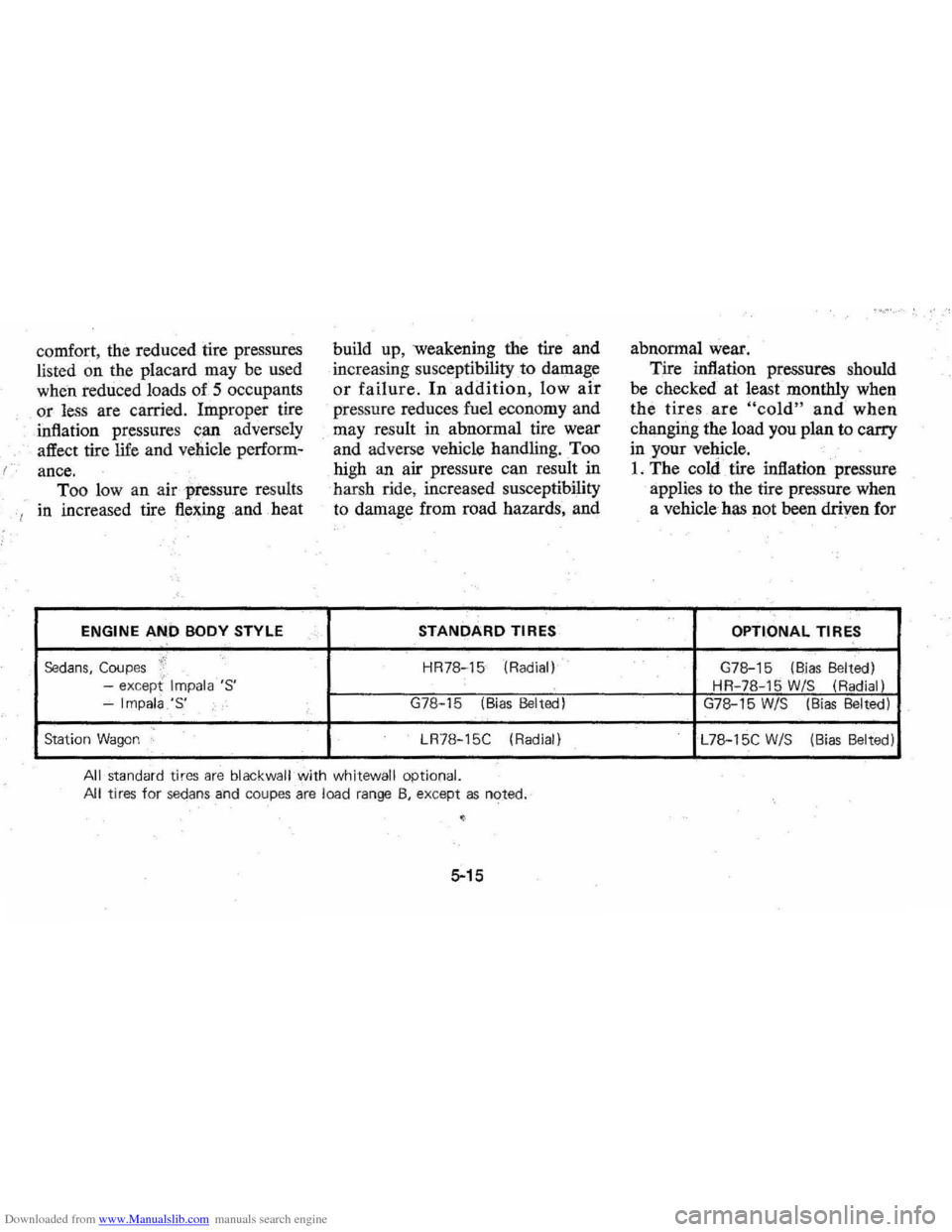
Downloaded from www.Manualslib.com manuals search engine co mfort, the reduced tire pressures
listed on the placard may
be used
when reduced loads of 5 occupants
or
less are carried. Improper tire
inflation pressures
c,an adversely
affect tire life and vehicle perform-
l' ance.
Too Iowan air 'pressure results
I in increased tire flellingand heat
ENGINE AN,D BODY STYLE
4' Sedans, Coupe s ;;' " -except Imp ala 'S '
~ Impala ,'S' ,
Station Wagon
,
.',
build up, weakening the tire and
increasing
sus ceptibility to damage
or failure. In addition, low air
pre ssure reduces fuel economy and
may result in abnormal tire wear
and adverse vehicle handling. Too
high an air pressure can re sult
in
har sh ride , increas ,ed su sceptibility
to dam a
ge fr om road hazards, and
STANDARD TIRES
HR78-15 (R adial)
G78-1 5 (Bias Belted)
LR7
8-1 5C (Radial)
All
sta ndard tires are blackwall With whi tewall optional.
All tires fo r sedan s a-nd co upes are load range 8, except as n ote d.
5-15
abnormal wear.
Tire inflation pressures should
be checked at least monthly when
the
tires , are "cold" and when
changing the load you plan
to carry
in your vehicle .
L The cold tire inflation pressure
applies
to the tire pressure when
a vehicle has not been driven for
OPTIONAL TIRES
G78-15 (Bias Belted)
HR-78-1 5
W/S (Ra dial)
G
78-15 W/S (Bias Belted)
L78-1 5C W/S (Bias Belted)
Page 77 of 102
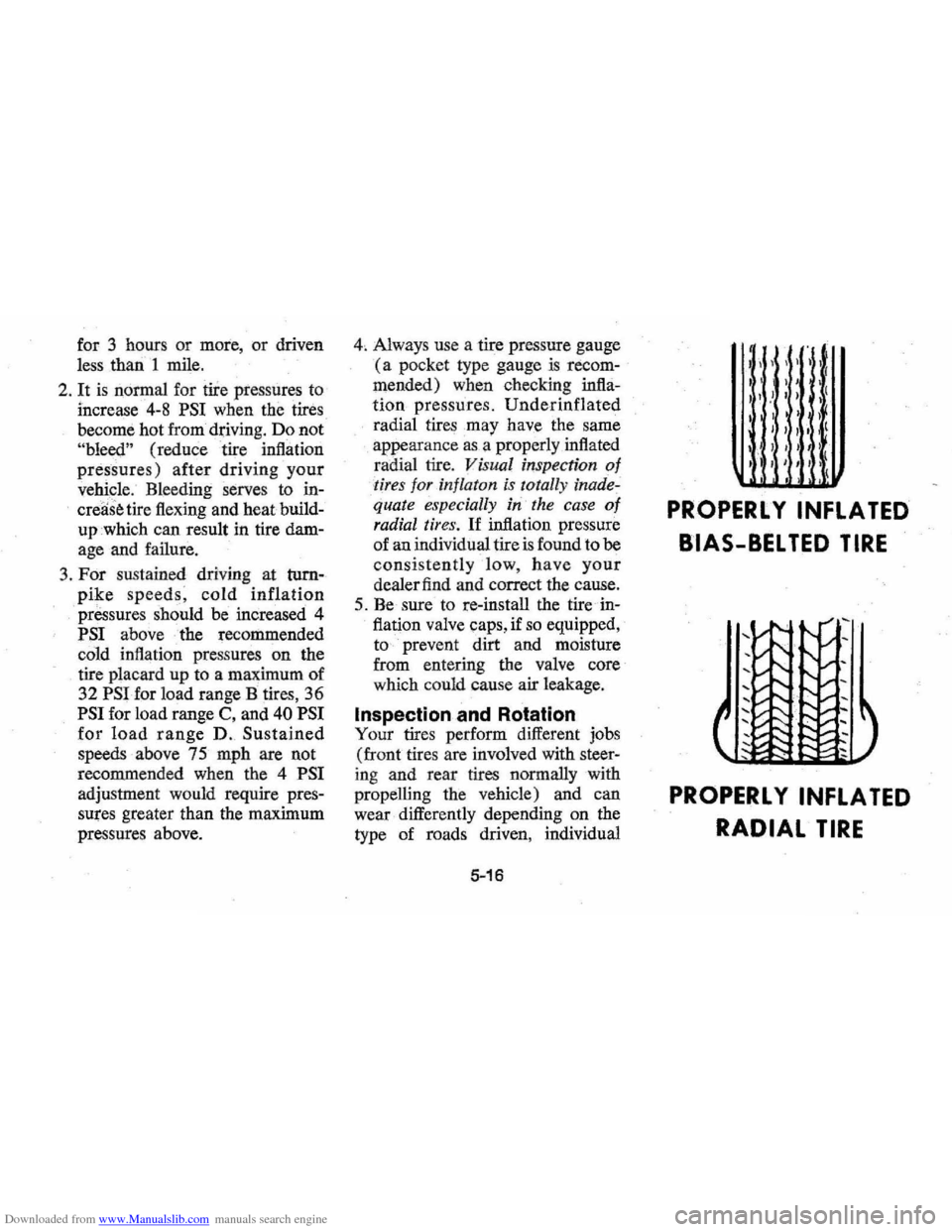
Downloaded from www.Manualslib.com manuals search engine for 3 hours or more, or driven
less than 1 mile.
2. It is normal for tiTe pressures to
increase 4-8 PSI when the tires
become hot from
driving. Do not
"bleed" (reduce tire inflation
pressures)
after driving your
vehicle. Bleeding serves
to in
crease tire flexing and heat build
up which can result in tire dam
age and failure.
3. For sustained driving
at turn
pike speeds; cold inflation
pressures should be increased 4
PSI above the recommended
cold inflation pressures on the
tire placard up
to a maximum of
32
PSI for load range B tires, 36
PSI for load range C, and 40 PSI
for load range D. Sustained
speeds above 75 mph are not
recommended when the 4
PSI
adjustment would require pres
sures greater than the maximum
pressures above.
4, Always use a tire pressure gauge
(a pocket type gauge is recom
mended) when checking infla
tion pressures. Underinflated
radial tires may have the same
appearance
as a properly inflated
radial tire.
Visual inspection of
-tires for in/laton is totally inade,
quate especially in the case 0/
radial tires. If inflation pressure
of an individual tire
is found to be
consistently low, have your
dealer find and correct the cause.
5. Be sure to re-install the tire in
flation valve caps, if
so equipped,
to prevent dirt and moisture
from entering the valve core
which could cause air leakage.
Inspection and Rotation
Your tires perform different jobs
(front tires are involved with steer
ing and rear tires normally with
propelling the vehicle) and can
wear differently depending on the
type of roads driven, individual
5-16
I
I '
,
)1, I
I I ( I , I , )' ,t
I ) I )
I , I I I I (
PROPERLY INFLATED
BIAS-BELTED TIRE
PROPERL Y INFLATED
RADIAL TIRE
Page 78 of 102

Downloaded from www.Manualslib.com manuals search engine LF RF LF
LR RR RR
.5 WHEEl ROTATION .. ··WHEEl ROTATION
RADIAL TIRES
BIAS PLY TIRE BIAS PLY TIRE .. WHEEl ROTATION .5 WHEEl ROTAtiON
BIAS-BELTED TIRES
driving habits, etc. To obtain maxi
mum. tire life you should inspect
a nd rotate your tires regularly.
Many car .and tire dealers will per
form a free tire inspection and
assist you in identifying uneven
or abnormal tire
wear which is
usually the result of incorrect infla
tion pressure , lack of regular rota
tion, improper wheel alignment,
out-of-balance ,
or poor driving
habits.
Bias and bias-belted tires should
be rotated
at least every 7,500
miles . Radial tires should be ro
tated at least at the first 7,500 miles
and then
at least at 15,000 mile in
tervals thereafter .or whenever. un
even tire wear is noticed.
Alignment and Balance
Proper front-end alignment ~i~i
mizes tire tread wear: To mlmmlze
tire wear, your front-end
susp~n
sion components should be m-
5-17
NOTE: It is recommended that the
brake s be
inspected for wear when
ever the tires are rotated.
spected regularly. See the
Main:e
nance Schedule folder for more lU
formation. Some ball-joints have
built-in wear indicators and some
movement in the joints
is normal.
Improper front -end alignment will
not cause vibration. Improper to e
alignment may cause your front.
tires to drag at an angle resulting in
excessive wear. Improper camber
alignment
may cause your front
tires to wear more on one side than
on the other arid can cau se the
vehicle to
"pull" to the left or right.
Proper tire balancing provides
the best riding comfort and helps
to minimiz e tire tread wear.
Out-of
balance tires can cause annoyin g
vehicle vibration and irregular tire
wear such
as cupping, flat spots,
etc.